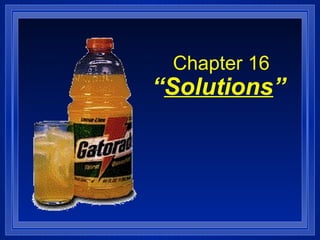
Chemistry - Chp 16 - Solutions - PowerPoint (shortened)
- 2. Section 16.1 Properties of Solutions OBJECTIVES: –Identifythe factors that determine the rate at which a solute dissolves.
- 3. Section 16.1 Properties of Solutions OBJECTIVES: –Identify the units usually used to express the solubility of a solute.
- 4. Section 16.1 Properties of Solutions OBJECTIVES: –Identify the factors that determine the mass of solute that will dissolve in a given mass of solvent.
- 5. Solution formation The “nature” (polarity, or composition) of the solute and the solvent will determine… 1. Whether a substance will dissolve 2. How much will dissolve Factors determining rate of solution... 1. stirring (agitation) 2. surface area the dissolving particles 3. temperature
- 6. Making solutions In order to dissolve, the solvent molecules must come in contact with the solute. 1. Stirring (agitation) moves fresh solvent into contact with the solute. 2. Smaller pieces increase the amount of surface area of the solute. - think of how fast a breath mint dissolves when you chew it
- 7. Temperature and Solutions 3. Higher temperature makes the molecules of the solvent move faster and contact the solute harder and more often. – Speeds up dissolving. Higher Temperature ALSO Usually increases the amount that will dissolve (an exception is gases, more on that later).
- 8. a. The solubility of the KNO3 increases as the temperature increases. b. Yb2(SO4)3 shows a decrease in solubility as the temperature increases, and NaCl shows the least change in solubility as temperature changes. c. Only a negligible amount of NaCl would go into solution, if any.
- 9. Solids tend to dissolve best when: •They are heated •They are stirred •Crushed into smaller particles Gases tend to dissolve best when: •The solution is cold •The pressure is high
- 10. How Much? Solubility- is the maximum amount of substance that will dissolve at a specific temperature. The units for solubility are: grams of solute/100 grams solvent 1) Saturated solution- Contains the maximum amount of solute dissolved. NaCl = 36.0 g/100 mL water 2) Unsaturated solution- Can still dissolve more solute (for example 28.0 grams of NaCl/100 mL) 3) Supersaturated- solution that is holding (or dissolving) more than it theoretically can; a “seed crystal” will make it come out.
- 11. Saturation and Equilibrium Solute is More solute is dissolving, Saturation dissolving but some is crystallizing equilibrium established
- 12. Supersaturated
- 13. Supersaturated Example Ever heard of “seeding” the clouds to make them produce rain? Clouds - mass of air supersaturated with water vapor Silver Iodide (AgI) crystals are dusted into the cloud as a “seed” The AgI attracts the water, forming droplets that attract others
- 14. Liquids Miscible means that two liquids can dissolve in each other – water and antifreeze – water and ethanol Partially miscible- slightly – water and ether Immiscible means they can’t – oil and vinegar
- 15. Solubility? For solids in liquids, as the temperature goes up-the solubility usually goes up For gases in a liquid, the effect is the opposite of solids in liquids – As the temperature goes up, gas solubility goes down – Think of boiling water bubbling? – Thermal pollution may result from industry using water for cooling
- 16. Section 16.2 Concentration of Solutions OBJECTIVES: –Solve problems involving the molarity of a solution.
- 17. Section 16.2 Concentration of Solutions OBJECTIVES: –Describe the effect of dilution on the total moles of solute in solution.
- 18. Section 16.2 Concentration of Solutions OBJECTIVES: –Define percent by volume and percent by mass solutions.
- 19. Concentration is... a measure of the amount of solute dissolved in a given quantity of solvent A concentrated solution has a large amount of solute A dilute solution has a small amount of solute – These are qualitative descriptions But, there are ways to express solution concentration quantitatively (NUMBERS!)
- 20. Concentrated CONCENTRATED vs. Dilute DILUTE Notice how Notice dark the how light solutions the appears. solution appears. Lots of solute, Small in a small amount of amount of solute in a solvent. large amount of solvent.
- 21. Molarity: a unit of concentration Molarity = moles of solute liters of solution • Abbreviated with a capital M, such as 6.0 M • This is the most widely used concentration unit used in chemistry.
- 22. - Page 481
